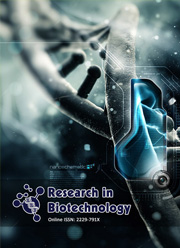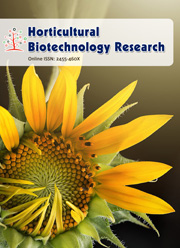Improvement of plant disease classification accuracy with generative model-synthesized training datasets
DOI:
https://doi.org/10.25081/rib.2023.v14.8214Keywords:
Plant disease phenotyping, Generative adversarial networks, Classification accuracy improvementAbstract
Digitalization in agriculture requires critical research into applications of artificial intelligence to various specialization domains. This work aimed at investigating the application of image synthesis technology to the mitigation of the data volume constraint to digital plant disease phenotyping accuracy. We designed an experiment involving the use of a deep convolutional generative adversarial network (DC-GAN) to synthesize photorealistic data for healthy and bacterial spot disease-infected tomato leaves. The training dataset contained 1,272 instances per class. We further employed a 3-block visual geometry group (VGG) convolutional neural network (CNN) model with dropout regularization and 1 epoch to compare classification accuracies of the original dataset and various synthetic datasets. Our results showed that the third DC-GAN synthesized training dataset containing 3,816 synthetic examples of both healthy and bacterial spot infected tomato leaf classes outperformed the original training dataset containing 1,272 real examples of both tomato leaf classes (77.088% accuracy with the former dataset on a 3-block VGG CNN model with dropout regularization and 1 epoch, as compared to 76.447% accuracy with the latter dataset on the same classifier).
Downloads
References
Bin, L., Cheng, T., Shuqin, L., Jinrong, H., & Hongyan, W. (2020). A Data Augmentation Method Based on Generative Adversarial Networks for Grape Leaf Disease Identification. IEEE Access, 8, 102188-102198. https://doi.org/10.1109/ACCESS.2020.2998839
Bresilla, K., Perulli, G. D., Boini, A., Morandi, B., Grappadelli, L. C., & Manfrini, L. (2019). Single-Shot Convolution Neural Networks for Real-Time Fruit Detection Within the Tree. Frontiers in Plant Science, 10. https://doi.org/10.3389/fpls.2019.00611
Brownlee, J. (2019a). Deep Learning for Computer Vision: Image Classification, Object Detection, and Face Recognition in Python. Machine Learning Mastery.
Brownlee, J. (2019b). Generative Adversarial Networks with Python: Deep Learning Generative Models for Image Synthesis and Image Translation. Machine Learning Mastery.
Castillo-Botón, C., Casillas-Pérez, D., Casanova-Mateo, C., Ghimire, S., Cerro-Prada, E., Gutierrez, P. A., Deo, R. C., & Salcedo-Sanz, S. (2022). Machine learning regression and classification methods for fog events prediction. Atmospheric Research, 272, 106157. https://doi.org/10.1016/j.atmosres.2022.106157
Chaturvedi, D. K. (2008). Factors Affecting the Performance of Artificial Neural Network Models. In D. K. Chaturvedi (Ed.), Soft Computing: Techniques and its Applications in Electrical Engineering (pp. 51-85) Berlin, Heidelberg: Springer. https://doi.org/10.1007/978-3-540-77481-5_4
Deng, H., Luo, D., Chang, Z., Li, H., & Yang, X. (2021). RAHC_GAN: A Data Augmentation Method for Tomato Leaf Disease Recognition. Symmetry, 13(9), 9. https://doi.org/10.3390/sym13091597
GitHub-Enowtakang. (n.d.). 1-GANs-study. Retrieved from https://github.com/Enowtakang/1-GANs-study
Giuffrida, M. V., Scharr, H., & Tsaftaris, S. A. (2017). ARIGAN: Synthetic Arabidopsis Plants using Generative Adversarial Network (p. 184259). bioRxiv. https://doi.org/10.1101/184259
Goodfellow, I. J., Pouget-Abadie, J., Mirza, M., Xu, B., Warde-Farley, D., Ozair, S., Courville, A., & Bengio, Y. (2014). Generative Adversarial Networks (arXiv:1406.2661). arXiv. https://doi.org/10.48550/arXiv.1406.2661
Gutiérrez, S., Fernández-Novales, J., Diago, M. P., & Tardaguila, J. (2018). On-The-Go Hyperspectral Imaging Under Field Conditions and Machine Learning for the Classification of Grapevine Varieties. Frontiers in Plant Science, 0. https://doi.org/10.3389/fpls.2018.01102
Howlader, K. C., Satu, Md. S., Awal, Md. A., Islam, Md. R., Islam, S. M. S., Quinn, J. M. W., & Moni, M. A. (2022). Machine learning models for classification and identification of significant attributes to detect type 2 diabetes. Health Information Science and Systems, 10(1), 2. https://doi.org/10.1007/s13755-021-00168-2
Jain, A., Patel, H., Nagalapatti, L., Gupta, N., Mehta, S., Guttula, S., Mujumdar, S., Afzal, S., Sharma Mittal, R., & Munigala, V. (2020). Overview and Importance of Data Quality for Machine Learning Tasks. Proceedings of the 26th ACM SIGKDD International Conference on Knowledge Discovery & Data Mining, 3561-3562. https://doi.org/10.1145/3394486.3406477
Jiang, T., Gradus, J. L., & Rosellini, A. J. (2020). Supervised Machine Learning: A Brief Primer. Behavior Therapy, 51(5), 675-687. https://doi.org/10.1016/j.beth.2020.05.002
Lu, Y., Chen, D., Olaniyi, E., & Huang, Y. (2022). Generative adversarial networks (GANs) for image augmentation in agriculture: A systematic review. Computers and Electronics in Agriculture, 200, 107208. https://doi.org/10.1016/j.compag.2022.107208
Mochida, K., Koda, S., Inoue, K., & Nishii, R. (2018). Statistical and Machine Learning Approaches to Predict Gene Regulatory Networks From Transcriptome Datasets. Frontiers in Plant Science, 9, 1770. https://doi.org/10.3389/fpls.2018.01770
Moghimi, A., Yang, C., Miller, M. E., Kianian, S. F., & Marchetto, P. M. (2018). A Novel Approach to Assess Salt Stress Tolerance in Wheat Using Hyperspectral Imaging. Frontiers in Plant Science, 10, 1182. https://doi.org/10.3389/fpls.2018.01182
Mohammadi-Dehcheshmeh, M., Niazi, A., Ebrahimi, M., Tahsili, M., Nurollah, Z., Ebrahimi Khaksefid, R., Ebrahimi, M., & Ebrahimie, E. (2018). Unified Transcriptomic Signature of Arbuscular Mycorrhiza Colonization in Roots of Medicago truncatula by Integration of Machine Learning, Promoter Analysis, and Direct Merging Meta-Analysis. Frontiers in Plant Science, 9, 1550. https://doi.org/10.3389/fpls.2018.01550
Nagano, S., Moriyuki, S., Wakamori, K., Mineno, H., & Fukuda, H. (2019). Leaf-Movement-Based Growth Prediction Model Using Optical Flow Analysis and Machine Learning in Plant Factory. Frontiers in Plant Science, 10, 227. https://doi.org/10.3389/fpls.2019.00227
Naik, N., & Purohit, S. (2017). Comparative Study of Binary Classification Methods to Analyze a Massive Dataset on Virtual Machine. Procedia Computer Science, 112, 1863-1870. https://doi.org/10.1016/j.procs.2017.08.232
Nazki, H., Yoon, S., Fuentes, A., & Park, D. S. (2019). Unsupervised Image Translation using Adversarial Networks for Improved Plant Disease Recognition (arXiv:1909.11915). arXiv. https://doi.org/10.48550/arXiv.1909.11915
Plant Village. (n.d.). GitHub. Retrieved from https://github.com/spMohanty/PlantVillage-Dataset
Shete, S., Srinivasan, S., & Gonsalves, T. A. (2020). TasselGAN: An Application of the Generative Adversarial Model for Creating Field-Based Maize Tassel Data. Plant Phenomics (Washington, D.C.), 2020, 8309605. https://doi.org/10.34133/2020/8309605
Simonyan, K., & Zisserman, A. (2015). Very Deep Convolutional Networks for Large-Scale Image Recognition (arXiv:1409.1556). arXiv. https://doi.org/10.48550/arXiv.1409.1556
Tabosa de Oliveira, T., da Silva Neto, S. R., Teixeira, I. V., Aguiar de Oliveira, S. B., de Almeida Rodrigues, M. G., Sampaio, V. S., & Endo, P. T. (2022). A Comparative Study of Machine Learning Techniques for Multi-Class Classification of Arboviral Diseases. Frontiers in Tropical Diseases, 2, 769968. https://doi.org/10.3389/fitd.2021.769968
Xu, M., Yoon, S., Fuentes, A., Yang, J., & Park, D. S. (2022). Style-Consistent Image Translation: A Novel Data Augmentation Paradigm to Improve Plant Disease Recognition. Frontiers in Plant Science, 12, 773142. https://doi.org/10.3389/fpls.2021.773142
Zhang, N., Rao, R. S. P., Salvato, F., Havelund, J. F., Møller, I. M., Thelen, J. J., & Xu, D. (2018). MU-LOC: A Machine-Learning Method for Predicting Mitochondrially Localized Proteins in Plants. Frontiers in Plant Science, 9, 634. https://doi.org/10.3389/fpls.2018.00634
Published
How to Cite
Issue
Section
Copyright (c) 2023 Enow Takang Achuo Albert, Ngalle Hermine Bille, Ngonkeu Mangaptche Eddy Leonard

This work is licensed under a Creative Commons Attribution-NonCommercial-NoDerivatives 4.0 International License.



 .
.